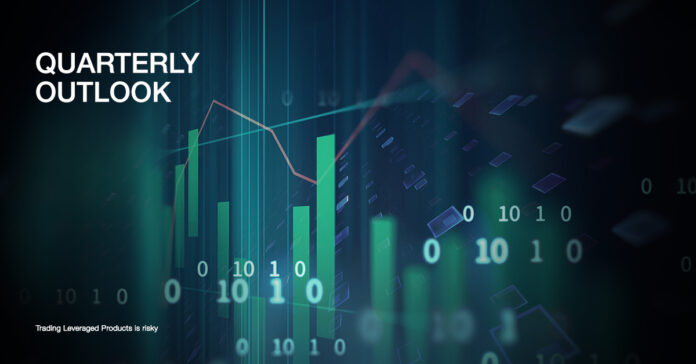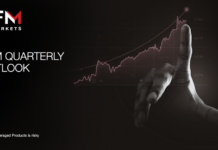Global stock markets had a torrid time in Q1 registering their worst quarterly performance for 2 years. With a strong USD, elevated commodity prices and record levels of price inflation, what does the remainder of Q2 herald for equities?
USA500
The US non-farm payrolls in March recorded the smallest gains since November last year, at 431k versus consensus expectation at 490k. The unemployment rate continued to hit a new low since February 2020, at 3.6%, while average hourly earnings printed at 5.6% versus market expectation of 5.5%. The market generally expects a 50 bp rate hike in the upcoming FOMC event and a further 50 bp increase before the end of the quarter. On the other hand, the development of the Russia-Ukraine war has served as a catalyst for a more aggressive monetary stance. An aggressive rate hike may slow down the economy over the long term. Recent treasury yield curve inversion may be an indicator for economic downturn, though it is not a guarantee and may take more than a year to occur after the yield curve inversion.
Both the US500 and US30 have experienced technical corrections since early January this year. Both printed lows on 20th February, at 4104 and 32164 respectively. The indices rebounded strongly in March, recouping more than half of the losses by the end of the quarter. By mid-April the key 4,400 level had been breached by the US500 and the US30 was trading down again at 34,450, both were below their respective 20-week SMA’s.
UK100
The UK100 tumbled to its lowest at 6,721 in early March following concerns over heightened geopolitical uncertainty. In general, the UK has few direct financial links to Russia, with the latter accounting for only 0.7% exports and 1.5% imports of UK goods and services. Nevertheless, any escalation of financial sanctions on energy trade could cause more damage in the longer term as the index includes some of the biggest companies in the oil industry. Shell, BP and ExxonMobil are among the British energy giants that have halted their operations in Russia. An increase in oil prices has also lead to higher input costs for local airline and automobile giants, thus hurting the corporate earnings. In March, the Bank of England raised its interest rate for the third time in a row, to 0.75%, but struck a more cautious tone on future hikes as growth outlook dims. GBPUSD remained pressured in Q1, with losses of nearly 5%. As most of the companies in the UK100 generate overseas earnings in USD, a weakening of the Pound does not increase the sterling value of their earnings, thus boosting the share prices and eventually the index. By the end of Q1 and into mid-April, the index recouped its losses and closed above 7,550. It is also well supported above the 20-week SMA.
GER40
The Russia-Ukraine developments serve as key drivers to the direction of GER40. Following a heavy plunge to the lows at 12,423, the index regained its support and closed the quarter at 14,500, before testing 14,100 by mid-April. The recovery was contributed by “significant progression” in talks between the two countries, with hope of a diplomatic solution. Still, the index has lost over 13% from the high seen in the beginning of this year. War shock, supply chain disruption, rising commodity prices, skyrocketing inflation – these issues remained even after Russia and Ukraine began peace talks, thus imposing a threat to Eurozone economic recovery. Monetary policy outlook remains an uncertainty. According to ECB board member Schnabel, the bank may extend its QE programme beyond the summer should the economy fall into deep recession.
NIKKEI
Lastly, the JP225 recouped more than 50% of the losses suffered in Q1, and last closed just below 27,000. Earlier, an optimistic sentiment towards cease-fire talks between Russia and Ukraine, strong economic data from China and the Chinese government’s favourable policy for technology stocks lifted the index. In addition, easing of Covid measures by the Japanese government allowed normalization of business activities in most parts of the country, thus serving as a tailwind for the Nikkei. In general, Yen weakening was caused by policy divergence between the BoJ and the other main central banks. Following weak consumer spending, Japan’s inflation data remains below the BoJ’s target. However, in the coming quarter, analysts expect inflation to approach 2% following an increase in fuel costs and the dissipating effect of cellphone fee cuts. Stagflation will be an issue to watch for as prices keep rising while the economy slumps.
Click here to access our Economic Calendar
Larince Zhang
Market Analyst
Disclaimer: This material is provided as a general marketing communication for information purposes only and does not constitute an independent investment research. Nothing in this communication contains, or should be considered as containing, an investment advice or an investment recommendation or a solicitation for the purpose of buying or selling of any financial instrument. All information provided is gathered from reputable sources and any information containing an indication of past performance is not a guarantee or reliable indicator of future performance. Users acknowledge that any investment in Leveraged Products is characterized by a certain degree of uncertainty and that any investment of this nature involves a high level of risk for which the users are solely responsible and liable. We assume no liability for any loss arising from any investment made based on the information provided in this communication. This communication must not be reproduced or further distribution.






















